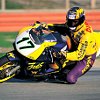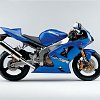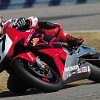MCN and Bike magazine in the U.K. surprised me yesterday with reports that Honda will discontinue the CBR600RR in that market after this year.
Bike quoted an unnamed source at Honda as saying, “We can’t justify further development costs on such a small number of sales.”
If that’s true then, without fuss, Honda cut an iconic Supersport model that’s been a stalwart on the street and the track for 30 years.
Time flies, eh?
I don’t want to believe that the model’s dead here in the U.S. market, too, but I have to admit that I’ve been in denial. It’s been obvious for a few years that Honda no longer had any stomach for the 600.
I contacted American Honda to ask about the CBR600RR's future here and Tony De Franze sent me an e-mail saying this about the U.K. reports: "It's basically unsubstantiated rumor at this point and the CBR600RR remains in our line-up as far as I am aware.”
Even if the British reports turn out to be untrue, just the fact that it’s even possible shows how times have changed dramatically.

When 600s ruled
It’s hard to say exactly when was the high-water mark for the 600 class, but I’d argue that from the mid-1990s through the mid-2000s it was the most finely honed displacement category of sport bikes.
Driven by competition in the showroom and on the race track, manufacturers updated their 600-class sport bikes every two years. In places like Hamamatsu, obsessive-compulsive engineers channeled their highly competitive urges into building ever-sharper 600s with the result that we mere consumers got bikes that offered more bang for our bucks, and more sheer fun — especially on the track — than any literbike. They were the closest things most of us would ever get to a real homologation special.

In the heyday of the AMA’s 600 Supersport class, Honda paid top riders like Miguel Duhamel to win races, in hopes that would translate into massive sales volumes. And indeed in those years dealers sold more 600s than anything else. But sales of all motorcycles took a massive hit in 2008 and 2009, and although the business has gradually come back, the recovery’s been led in the sport category by sales of high priced open-class bikes on one end and entry-level bikes at the other.
The 600s have been caught in the middle. They’re nearly as expensive to manufacture as open-class bikes but must be sold for thousands of dollars less.
This is not a beginner bike
For years, when motorcycle writers and ex-racers commiserated over beers at new-model launches, we complained about manufacturers hurting themselves (figuratively) and new riders (literally) with the idea that 600s were beginner bikes. Nothing could’ve been further from the truth. A 100-horsepower 600 cc race replica is a thoroughbred that rewards corner speed and gear discipline. Riders need to reprogram their hearing — and indeed their whole way of thinking. You know that exhaust note where the engine seems to be screaming for mercy? That’s actually the point where a 600 is about to come on the cam and start working as intended.
Beginner-friendly? Hardly. Racer-friendly? Definitely.
But dealers were stuck trying to sell them that way.

Change began even before the Great Recession forced it. Kawasaki — the smallest of the Japanese “Big Four” — took a drastic step in 2002 and increased the displacement of the base ZX-6R to 636 cc. Kawasaki was tired of the 600-class arms race, and the bikes were increasingly track-focused, to their detriment as transportation. That extra few ccs made the ZX-6R the best of the bunch, on the street. The next year, Triumph raised the displacement of the four-cylinder Daytona to 650 cc and in 2006 Triumph changed the real-world equation by introducing a 675 cc triple that was still legal for the race class.
The recession forced faster change. Kawasaki and Yamaha settled on a whole new class of 300 cc sport bikes and KTM upped the cool factor with the RC390. Sporty bikes like the Honda CBR650F, Kawasaki Ninja 650 and Yamaha FZ6R provided alternatives better suited to the street and now Suzuki has brought back the venerable SV650. Suddenly there are all kinds of bikes that are cool and novice-friendly. They’re more affordable than 600s, and better suited to the riding most of us – even experienced riders – do most of the time, anyway.
So who’s left buying 600s? Answer: hardly anyone.
“Win on Sunday, sell on Monday”?

The truth was more like, “Sell Tuesday through Saturday, so the Board of Directors will let us race Sunday.”
Thus, our situation: The 600 Supersport class is important in almost all domestic championships (including MotoAmerica); there’s the FIM World Supersport Championship; even the Moto2 support class runs four-cylinder 600 cc spec motors (supplied by Honda!)
So around the world, we still appear to be committed to racing motorcycles that no one wants to buy any more.
Before wondering where this leads, it’d be useful to review how we got here.
The often controversial Roger Edmondson is generally credited with creating the SuperSport class, as part of his Championship Cup Series, in 1984. The AMA co-opted the Supersport concept and created a 600 cc national championship in 1987. Doug Polen won every race that year, on the first Honda CBR600 (although people still called it a Hurricane back then).
Supersport was elevated to a full World Championship in 1999. That was also the first year that it appeared as a class on the Isle of Man, although before long the Junior class was effectively filled with Supersport bikes.

Riders like Duhamel and Nicky Hayden won championships on Honda 600s in the United States, and in the glory years of the 1990s, CBR600F2 and F3 models were Honda’s top sellers, so it didn’t matter if “Win on Sunday, sell on Monday” was actually true or not. The racing department and the bean counters were both happy.
I rode everyone’s 600s in the early 2000s, and although all had their virtues, I consistently scored the Yamaha YZF-R6 at or near the top. That’s not to say that Honda rested on its laurels. It didn’t. In 2003, it introduced the CBR600RR, claiming that its dimensions were inspired by Valentino Rossi’s MotoGP bike, and won a string of Supersport World Championships with the RR.
Since the Great Recession, development in the class slowed, especially at Honda. Sure, it was updated for 2009 and 2013… but barely. Although Honda’s combined ABS is a technological marvel, the current CBR600RR is missing niceties like a quick-shifter and traction control — not mention a few horsepower.
At this point, it’s not a question of whether the current Supersport racing class structure will become obsolete, it’s a question of when. I’ve heard that it costs race teams almost as much to build a competitive Supersport bike as it does to build a full-on Superbike. Meanwhile, new 600s are increasingly rare on the road; their place is being taken by a more diverse and user-friendly group of bikes with strange displacements — 300, 390, 636, 675 cc — that we rarely heard mentioned in the glory days of the Supersport class.
That’s actually a good thing in the marketplace. But if your motorcycling world view has been shaped at the track, rather than in traffic, the thought of the last CBR600 and the demise of the Supersport class is sad.
Not to put too fine a point on it… progress is a bastard.
Back in the day, I rode all the “thousands,” too. But I have to admit that every time I walked away from a ZX-10R or a Gixxer thou’, I imagined it snickering, “Is that all you’ve got?”
I remember the launch of the 2007 CBR600RR. I walked away from that one thinking, “That’s all I need.”














